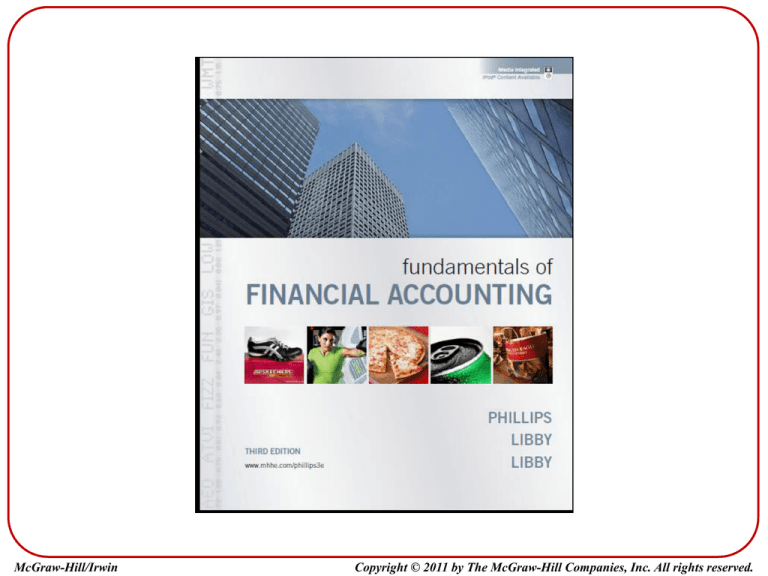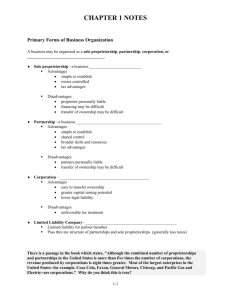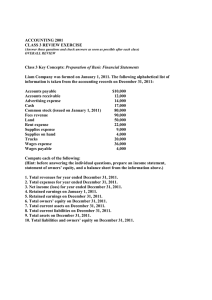
McGraw-Hill/Irwin
Copyright © 2011 by The McGraw-Hill Companies, Inc. All rights reserved.
Chapter 1
Business Decisions and Financial
Accounting
PowerPoint Authors:
Susan Coomer Galbreath, Ph.D., CPA
Charles W. Caldwell, D.B.A., CMA
Jon A. Booker, Ph.D., CPA, CIA
Fred Phillips, Ph.D., CA
Organizational Forms
Sole
Proprietorship
Business organization owned by
one person. The owner is
personally liable for all debts of
the business.
Partnership
Business organization owned by
two or more people. Each partner
is personally liable for all debts of
the business.
Corporation
1-3
A separate entity from both a legal
and accounting perspective.
Owners of corporations
(stockholders) are not personally
responsible for debts of the
corporation.
The Accounting System
Business and
Financing Activities
Accounting
System
Accounting Reports
External users
(creditors, investors, etc.)
Financial
Managerial
Internal users
(managers, etc.)
Accounting is a system of analyzing, recording,
summarizing and reporting the results of a
business’s activities.
1-4
The Basic Accounting Equation
Resources Owned . . .
by the company
Resources Owed . . .
to creditors
to stockholders
Assets = Liabilities + Stockholders’ Equity
Separate Entity
Assumption
Requires that a business’s
financial reports include
only the activities of the
business and not those of
its stockholders.
1-5
Assets
Resources controlled by the
company that have
measurable value and are
expected to provide future
benefits to the company.
Cash
Equipment
Supplies
1-6
Furniture
Liabilities
Amounts owed by
the business to
creditors.
Notes
Payable
1-7
Accounts
Payable
Stockholders’ Equity
Owners’ claim to the
business resources.
Contributed
Capital
Retained
Earnings
Stock Certificate
1-8
Revenues, Expenses and Net Income
Revenues – Expenses = Net Income
Revenues
Sales of goods or services
to customers. They are
measured at the
amount the business
charges the customer.
1-9
Expenses
The costs of business
necessary to earn
revenues, including
wages to employees,
advertising, insurance,
and utilities.
Dividends
Distributions of a
company’s earnings to its
stockholders as a return
on their investment.
Dividends are not an expense.
1-10
Financial Statements
Income
Statement
Statement
of Retained
Earnings
Financial
statements are
typically prepared in
this order.
Balance
Sheet
Statement
of Cash
Flows
1-11
The Income Statement
PIZZA AROMA, INC.
Income Statement
For the Month Ended September 30, 2010
Revenues
Pizza Revenue
$ 11,000
Total Revenue
11,000
Expenses
Supplies Expense
Wages Expense
Rent Expense
Utilities Expense
Insurance Expense
Advertising Expense
Income Tax Expense
Total Expenses
Net Income
1-12
$
4,000
2,000
1,500
600
300
100
500
9,000
2,000
The unit of
measure
assumption
Reports
the
states that
amount
results ofof
revenues
business
activities
less
should be
expenses
reported
in an
for
a period
appropriate
of time.
monetary
unit.
The Statement of Retained Earnings
PIZZA AROMA, INC.
Statement of Retained Earnings
For the Month Ended September 30, 2010
Retained Earnings, Sept. 1, 2010
$
Add: Net Income
2,000
Subtract: Dividends
(1,000)
Retained Earnings, Sept. 30, 2010
$ 1,000
Reports the way that net income and the
distribution of dividends affected the financial
position of the company during the period.
1-13
The Balance Sheet
Reports at a point in time:
1. What a business owns
(assets).
2. What it owes to
creditors (liabilities).
3. What is left over for the
owners of the
company’s stock
(stockholders’ equity).
PIZZA AROMA, INC.
Balance Sheet
At September 30, 2010
Assets
Cash
Accounts Receivable
Supplies
Equipment
Total Assets
Liabilities
Accounts Payable
Notes Payable
Total Liabilities
Stockholders' Equity
Contributed Capital
Retained Earnings
Total Stockholders' Equity
Total Liabilities and Stockholders' Equity
BASIC ACCOUNTING EQUATION
Assets = Liabilities + Stockholders’ Equity
1-14
$ 14,000
1,000
3,000
40,000
$ 58,000
$
7,000
20,000
27,000
30,000
1,000
31,000
$ 58,000
The Statement of Cash Flows
PIZZA AROMA, INC.
Statement of Cash Flows
For the Month Ended September 30, 2010
Cash Flows from Operating Activities
Cash collected from customers
$
Cash paid to suppliers and employees
Cash Provided by Operating Activities
Cash Flows from Investing Activities
Cash paid to buy equipment
Cash Used in Investing Activities
Cash Flows from Financing Activities
Capital contributed by stockholders
Cash dividends paid to stockholders
Cash borrowed from the bank
Cash Provided by Financing Activities
Change in Cash
Beginning Cash Balance, Sept. 1, 2010
Ending Cash Balance, Sept. 30, 2010
$
1-15
10,000
(5,000)
5,000
(40,000)
(40,000)
30,000
(1,000)
20,000
49,000
14,000
14,000
Summarizes
how a
business’s
operating,
investing, and
financing
activities
caused its
cash balance
to change over
a particular
period of time.
Relationships Among the Financial Statements
PIZZA AROMA, INC.
Income Statement
For the Month Ended September 30, 2010
Revenues
Pizza Revenue
$
11,000
Total Revenue
11,000
Expenses
Supplies Expense
Wages Expense
Rent Expense
Utilities Expense
Insurance Expense
Advertising Expense
Income Tax Expense
Total Expenses
Net Income
$
4,000
2,000
1,500
600
300
100
500
9,000
2,000
PIZZA AROMA, INC.
Statement of Retained Earnings
For the Month Ended September 30, 2010
Retained Earnings, Sept. 1, 2010
$
Add: Net Income
2,000
Subtract: Dividends
(1,000)
Retained Earnings, Sept. 30, 2010
$ 1,000
1-16
Net income
flows from the
Income
Statement to
the Statement
of Retained
Earnings.
1
Relationships Among the Financial Statements
PIZZA AROMA, INC.
Balance Sheet
At September 30, 2010
Ending Retained
Earnings flows from
the Statement of
Retained Earnings to
the Balance Sheet.
2
PIZZA AROMA, INC.
Statement of Retained Earnings
For the Month Ended September 30, 2010
Retained Earnings, Sept. 1, 2010
$
Add: Net Income
2,000
Subtract: Dividends
(1,000)
Retained Earnings, Sept. 30, 2010
$ 1,000
1-17
Assets
Cash
Accounts Receivable
Supplies
Equipment
Total Assets
Liabilities
Accounts Payable
Notes Payable
Total Liabilities
Stockholders' Equity
Contributed Capital
Retained Earnings
Total Stockholders' Equity
Total Liabilities and Stockholders' Equity
$ 14,000
1,000
3,000
40,000
$ 58,000
$
7,000
20,000
27,000
30,000
1,000
31,000
$ 58,000
Relationships Among the Financial Statements
PIZZA AROMA, INC.
Statement of Cash Flows
For the Month Ended September 30, 2010
Cash Flows from Operating Activities
Cash collected from customers
$
Cash paid to suppliers and employees
Cash Provided by Operating Activities
Cash Flows from Investing Activities
Cash paid to buy equipment
Cash Used in Investing Activities
Cash Flows from Financing Activities
Capital contributed by stockholders
Cash dividends paid to stockholders
Cash borrowed from the bank
Cash Provided by Financing Activities
Change in Cash
Beginning Cash Balance, Sept. 1, 2010
Ending Cash Balance, Sept. 30, 2010
$
PIZZA AROMA, INC.
Balance Sheet
At September 30, 2010
10,000
(5,000)
5,000
(40,000)
(40,000)
30,000
(1,000)
20,000
49,000
14,000
14,000
Assets
Cash
Accounts Receivable
Supplies
Equipment
Total Assets
Liabilities
Accounts Payable
Notes Payable
Total Liabilities
Stockholders' Equity
Contributed Capital
Retained Earnings
Total Stockholders' Equity
Total Liabilities and Stockholders' Equity
$ 14,000
1,000
3,000
40,000
$ 58,000
$
7,000
20,000
27,000
30,000
1,000
31,000
$ 58,000
Cash on the Balance Sheet and Cash at End
of Year on the Statement of Cash Flows agree.
3
1-18
End of Chapter 1







